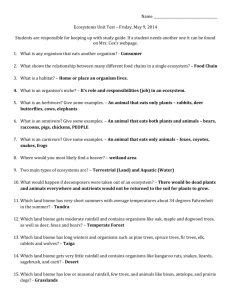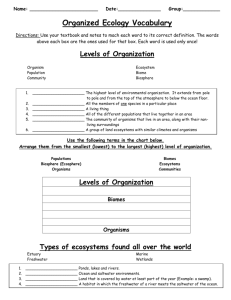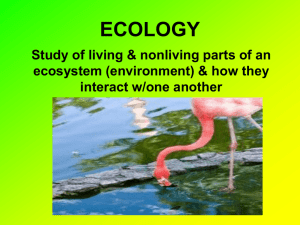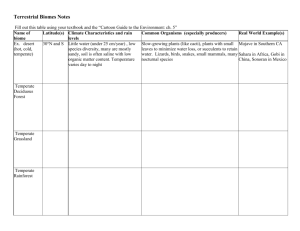Ecology Study Guide Key
advertisement
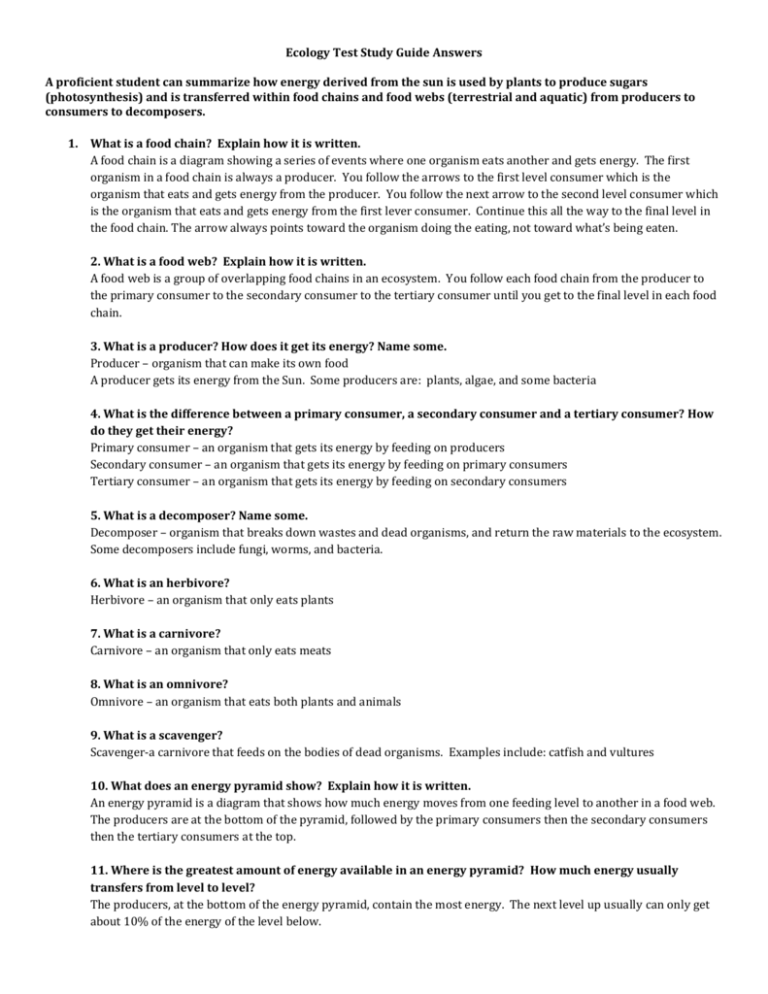
Ecology Test Study Guide Answers A proficient student can summarize how energy derived from the sun is used by plants to produce sugars (photosynthesis) and is transferred within food chains and food webs (terrestrial and aquatic) from producers to consumers to decomposers. 1. What is a food chain? Explain how it is written. A food chain is a diagram showing a series of events where one organism eats another and gets energy. The first organism in a food chain is always a producer. You follow the arrows to the first level consumer which is the organism that eats and gets energy from the producer. You follow the next arrow to the second level consumer which is the organism that eats and gets energy from the first lever consumer. Continue this all the way to the final level in the food chain. The arrow always points toward the organism doing the eating, not toward what’s being eaten. 2. What is a food web? Explain how it is written. A food web is a group of overlapping food chains in an ecosystem. You follow each food chain from the producer to the primary consumer to the secondary consumer to the tertiary consumer until you get to the final level in each food chain. 3. What is a producer? How does it get its energy? Name some. Producer – organism that can make its own food A producer gets its energy from the Sun. Some producers are: plants, algae, and some bacteria 4. What is the difference between a primary consumer, a secondary consumer and a tertiary consumer? How do they get their energy? Primary consumer – an organism that gets its energy by feeding on producers Secondary consumer – an organism that gets its energy by feeding on primary consumers Tertiary consumer – an organism that gets its energy by feeding on secondary consumers 5. What is a decomposer? Name some. Decomposer – organism that breaks down wastes and dead organisms, and return the raw materials to the ecosystem. Some decomposers include fungi, worms, and bacteria. 6. What is an herbivore? Herbivore – an organism that only eats plants 7. What is a carnivore? Carnivore – an organism that only eats meats 8. What is an omnivore? Omnivore – an organism that eats both plants and animals 9. What is a scavenger? Scavenger-a carnivore that feeds on the bodies of dead organisms. Examples include: catfish and vultures 10. What does an energy pyramid show? Explain how it is written. An energy pyramid is a diagram that shows how much energy moves from one feeding level to another in a food web. The producers are at the bottom of the pyramid, followed by the primary consumers then the secondary consumers then the tertiary consumers at the top. 11. Where is the greatest amount of energy available in an energy pyramid? How much energy usually transfers from level to level? The producers, at the bottom of the energy pyramid, contain the most energy. The next level up usually can only get about 10% of the energy of the level below. 12. Which way does energy flow in a food chain? In a food web? In an energy pyramid? Energy flows up from the producer to the primary consumer to the secondary consumer to the tertiary consumer in a food chain. It flows the same way in a food web and in an energy pyramid. 13. Explain how population changes can affect a food chain? When a population increases substantially, their members will have to compete for food. That will mean less food is available and that population will start to decrease. When a population decreases substantially, more food will become available because less members will be competing for the same food. That means more members will survive, reproduce, and the population will begin to grow. A proficient student can summarize how the abiotic factors (such as temperature, water, sunlight, and soil quality) of biomes (freshwater, marine, forest, grasslands, desert, Tundra) affect the ability of organisms to grow, survive and/or create their own food through photosynthesis. 14. How does sunlight affect the amount of living organisms in a freshwater or marine ecosystem? Sunlight is the source of energy for almost every living organism on Earth. Since almost all producers get their energy from the Sun, there won’t be many producers where sun cannot be absorbed (in the deeper parts of a freshwater or marine ecosystem. That means there won’t be many consumers in the deeper layers either, because they won’t have a lot of food sources available to them. Most of the living organisms in a freshwater or marine ecosystem will be found closer to the surface of the water. 15. What is a biome? Describe the major biomes (freshwater, marine, forest, grassland, desert, tundra) with an emphasis on temperature, precipitation, and organisms found there. A biome is a group of land ecosystems with similar climates and organisms. Freshwater Biome - Streams, ponds, rivers, lakes, etc./strongly affected by sunlight, temperature, oxygen content and salt content/only enough light in shallow water or near surface for photosynthesis/organisms may have adaptations to withstand strong currents Marine Biome – salt water areas/strongly affected by sunlight, temperature, oxygen content and salt content/ 3 zones (intertidal zone, neritic zone, open ocean)/only enough light in shallow water or near surface for photosynthesis Forest Biome – Deciduous forest biome and Boreal forest biome/cooler winters, warmer summers/ 50+ cm. of rain per year/many plant and animal species/much migration and hibernation during winter/Deciduous forest biome has deciduous trees like oaks and maples that shed leaves and grow new ones each year/Boreal forest biome has coniferous trees that produce seeds in cones, like spruce and fir trees/Boreal Forest is also known as the Taiga Grassland Biome - more comfortable temperatures/more rain than desert but less rain that most trees need to grow/ tall grasses/largest animals live here (rhinos, elephants, giraffes, lions, etc.)/ fires and droughts are common Desert Biome – searing summer heat/ some have temperature extremes of hot and cold/ less than 25 cm of rain per year and some get none/amount of evaporation is greater than the amount of precipitation Rainforest – Temperate and Tropical rainforests/ huge trees/ LOTS of rain/ astounding variety of plants and millions of species of insects, reptiles, birds and mammals/more species in tropical rainforest than all the other biomes combined/ 3 layers in tropical rainforest (canopy, understory, and forest floor) Tundra Biome – extremely cold and dry/most soil frozen all year round (permafrost)/bird migration/ if animals stay all winter they must have thick fur coats 16. What is the difference between a biotic factor and an abiotic factor? Biotic factors – living parts of an organism’s habitat Abiotic factors – non-living things of an organism’s habitat (like sunlight, temperature, water, oxygen, soil) 17. Explain how abiotic factors can affect populations. The amount of sunlight affects how many producers can make their own food by photosynthesis, which in turn affects how much food will be available for the consumers. The quality of the soil can affect which plants and how many can grow and serve as food for a population of consumers. Since most animals require oxygen to live, the amount of oxygen in their environment and the air quality can impact a population’s ability to survive. Salt content affects which aquatic organisms can survive in a freshwater or marine environment. All organisms need a certain amount of water or they will not survive. 18. Explain how biotic factors can affect populations. Some organisms use other organisms for shelter (birds living in a tree)-if there is not enough shelter, the population will decrease; some organisms compete with other organisms for the same resources (like the same food and water sources)-if there is not enough food, the population will decrease; some organisms prey on other organisms-if the population of predators goes up, the population of prey will go down for a while. When the population of prey goes low enough that there is not enough food for the predators, then the population of predators will go down, and the population of prey will start to come back up. 19. Put the following in order from smallest to largest: biome, population, organism, ecosystem, community Smallest: Organism Population Community Ecosystem Biome 20. What is the difference between a predator and prey? Prey is the species being killed; Predator is the species doing the killing (for example a snake (predator) eating a mouse(prey)) 21. What does the term “limiting factors” mean in Ecology? Name some limiting factors and explain how they might affect populations. Limiting factors – environmental factor that causes a population to decrease (for example: food, water, space, and weather conditions) Food – if there is not enough food, some of the organisms will die and the population will go down Water- if there is not enough water, some of the organisms will die and the population will go down If there is not enough space, some of the organisms will not be able to find shelter and the population will go down Severe weather like tornadoes, hurricanes, lightening (resulting in forest fires) can destroy the organisms’ homes (and/or kill them) and the population would go down. Extreme temperatures could kill organisms which do not have adaptations that allow them to survive those temperatures and the population would go down.


